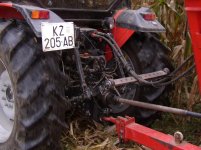I put up a reply saying that the max constant angle was 27 degrees, this was for automotive use and since then I have looked at varios websites concerning UJ angles and they all quote differant maximum angles so It dousnt make it easy.
If you look at the drive shaft angle between the drive axles on a truck/tractor unit (Called the "Jack shaft" here), the angles are quite severe, more so when the axles are oscillating over uneven ground.
One thing that has not been mentioned here is that the UJ Yokes must be in line on the same shaft, eg, if the shaft is splined in the middle and can come apart, when assembled, the yokes that hold the universal joint MUST be lined up or "In Phase". All Agricultural shafts that I have seen can only be assembled one way to ensure this happens.
I accidently assembled the rear shaft on my 4WD once, one spline out and when I tried to drive away there was this terrible banging from underneath and the rear of the vehicle was trying to twist on the springs so that alignment is very important.
I think if you are having continuing issiues with shaft angles then a hydraulic motor may be a worthwhile option.
This has the advantage that the motor speed is infinitly variable irrispective of what the tractor engine rpm is.
Cheers
Roscoe
